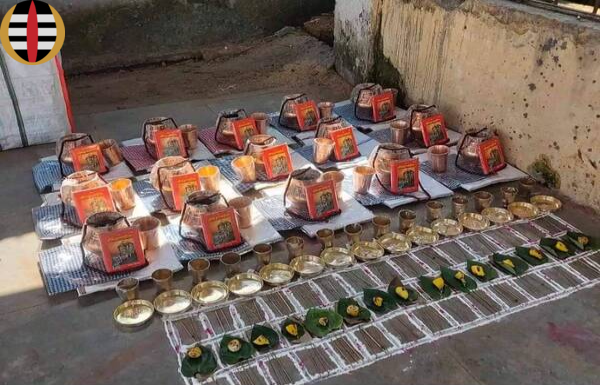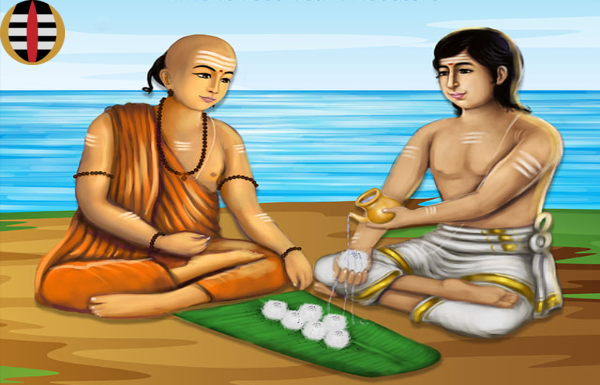Pitru Paksha Shradh Puja | Book Shraadh Puja, Tarpan
Pitru Paksha is a sacred period in Hinduism dedicated to paying respect and performing rituals for deceased ancestors. The word “Pitru” means ancestors, and “Paksha” refers to the lunar fortnight. During this period, Hindus perform the Shradh Puja, a ritual to honor and appease the souls of departed family members. The observance is rooted in the belief that by conducting these rites, ancestors bless their descendants with prosperity, health, and success. This ritual is an expression of gratitude and respect for the deceased, ensuring their peaceful afterlife.
What is Pitru Paksha?
Pitru Paksha occurs during the Krishna Paksha (waning phase of the moon) in the Hindu month of Bhadrapada (September-October). This fortnight is believed to be the time when the spirits of the ancestors descend to Earth to accept offerings from their living relatives. These offerings are believed to release the spirits from any unsettled karmic bonds, granting them peace in the afterlife. Pitru Paksha Shradh is not only a personal family event but also a communal activity observed by millions of Hindus worldwide.
Significance of Shradh Puja During Pitru Paksha
The Shradh Puja performed during Pitru Paksha is considered to hold immense religious and spiritual significance. It is said that failing to perform these rites may lead to displeased ancestors, which can bring bad luck or hardships to the family. Therefore, Hindus view the observance of Shradh as a moral and spiritual duty, offering prayers and food to their forefathers. According to Hindu beliefs, the Pitrus (spirits of the ancestors) live in the Pitruloka, a realm between heaven and Earth, and they visit the mortal world during Pitru Paksha to receive offerings made by their descendants.
Spiritual and Religious Importance
The Garuda Purana, an ancient Hindu scripture, emphasizes the importance of performing Shradh to appease the departed souls. By offering Pind Daan (rice balls mixed with ghee and sesame seeds) and performing the Tarpan (offering water mixed with black sesame seeds), families believe they can provide nourishment to their ancestors in the afterlife. This, in turn, is believed to free them from any residual suffering, granting them liberation or Moksha. Furthermore, the blessings from satisfied ancestors are believed to lead to prosperity, protection, and spiritual growth for the family.
How to Perform Pitru Paksha Shradh Puja
Choosing the Right Date
The ritual is typically performed on the Tithi (lunar day) corresponding to the death anniversary of the ancestor, but if the exact date is unknown, it can be done on Mahalaya Amavasya, the last day of Pitru Paksha. This day is considered highly auspicious and is known for bringing the blessings of all ancestors, irrespective of their exact death anniversaries.
The Rituals of Shradh Puja
- Purification and Prayer
The Shradh ritual begins with the purification of the body and home. The family performing the puja takes a bath and wears clean, simple clothes. It is essential to maintain a sacred and pure environment during the puja. - Pind Daan
Pind Daan is the central part of Shradh Puja. The family prepares Pinds made of cooked rice, barley, and ghee, which are offered to the ancestors. These Pinds represent the physical form of the ancestors and are believed to be consumed by them in the spiritual realm. - Tarpan
Tarpan involves offering water mixed with black sesame seeds and barley to the ancestors. It is performed with specific mantras that invoke the blessings of the ancestors. This is considered a way to satisfy the thirst of the departed souls. - Brahmin Bhojan
After performing the rituals, it is customary to feed Brahmins (priests) and offer them gifts or Dakshina. It is believed that feeding Brahmins is equivalent to feeding the ancestors, and their blessings will reach the departed souls. - Offering Food to Crows
A unique aspect of the Pitru Paksha Shradh Puja is feeding crows, who are regarded as messengers of Yama, the god of death. Offering food to crows is believed to ensure that the offerings reach the ancestors.
Essential Items for Shradh Puja
The following items are traditionally used during Pitru Paksha Shradh Puja:
- Pind Daan (rice balls)
- Black sesame seeds
- Barley
- Ghee
- Water
- Sandalwood paste
- Incense sticks
- Flowers
- Banana leaves (for serving food)
- Offerings of fruits, sweets, and specific dishes loved by the departed soul
Who Should Perform the Shradh Puja?
Shradh Puja is typically performed by the eldest son of the family, as he is considered the heir responsible for ensuring the ancestors’ spiritual well-being. If the eldest son is unable to perform the puja, any male descendant can perform the rites. In certain cases, women can also participate in the rituals, particularly if there are no male descendants.
Benefits of Performing Shradh Puja
The act of performing Shradh Puja brings several spiritual and material benefits, according to Hindu beliefs. The key benefits include:
- Liberation of Ancestors: By performing the Shradh rites, the ancestors are believed to attain peace and be freed from the cycle of rebirth, leading them to Moksha (liberation).
- Ancestral Blessings: It is believed that appeased ancestors bless their descendants with wealth, happiness, and success. Their blessings are seen as vital for a prosperous family life.
- Removal of Pitra Dosha: According to astrology, failure to perform Shradh can lead to Pitra Dosha, a form of ancestral curse that can create hurdles in life. By observing the Shradh Puja, one can remove this dosha and lead a harmonious life.
- Enhancing Spiritual Growth: Performing Shradh not only honors ancestors but also strengthens one’s connection with their lineage, fostering spiritual growth and understanding of life’s cyclical nature.
Importance of Feeding the Needy During Pitru Paksha
Apart from the rituals performed for the ancestors, it is considered highly auspicious to donate food, clothes, and money to the poor and needy during Pitru Paksha. Acts of charity are seen as a way to accumulate good karma and seek divine blessings. Feeding the needy symbolizes selfless service and is believed to reach the ancestors, enhancing their happiness and peace.
Key Pitru Paksha Dates in 2024
- Pitru Paksha Start Date: September 17, 2024
- Mahalaya Amavasya: October 2, 2024
Conclusion
Pitru Paksha Shradh Puja is a deeply meaningful ritual that goes beyond religious observance. It is a spiritual practice that connects the living with their ancestors, allowing for gratitude, remembrance, and the fulfillment of familial duties. Performing the rituals with sincerity and devotion is believed to bring peace to the departed souls and blessings to the descendants. Observing Shradh Puja during Pitru Paksha is a vital part of Hindu tradition, underscoring the importance of family, respect, and continuity of the soul’s journey.


